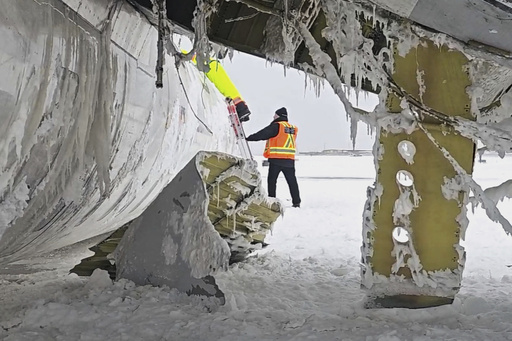
After witnessing footage of a Delta Air Lines aircraft engulfed in flames whilst landing and subsequently overturning on a runway in Toronto, one might question the survival of everyone on board. Surprisingly, aviation experts indicate that it is remarkable but not unexpected that all 76 passengers and four crew members emerged from the incident, with just 21 individuals sustaining minor injuries and only one still hospitalized as of Wednesday. This outcome is largely attributed to advancements in aircraft design and the proficient execution of the evacuation plan by the crew.
Michael McCormick, an assistant professor at Embry-Riddle Aeronautical University, expressed his astonishment at the sight of the aircraft upside down, questioning how anyone could survive. However, he noted that the successful evacuation of passengers was astounding. Experts, including McCormick, have emphasized that the minimal injuries reported demonstrate significant improvements in passenger jet design and engineering over the years.
One notable feature is the design of fuel tanks, which are located within the wings, allowing these wings to detach upon impact to mitigate severe fire hazards. Additionally, the aircraft’s vertical stabilizer is engineered to break easily, enabling a flipped plane to maintain stability on the ground, facilitating an efficient evacuation for passengers and crew. McCormick reassured that aviation continues to be the safest mode of transportation, attributing the survival of those involved in the Toronto incident to the ongoing enhancements in aviation safety.
Jeff Guzzetti, a safety consultant and former investigator for the Federal Aviation Administration, added that the design of seats and seatbelts played a crucial role in preventing fatalities. With the ability to withstand forces up to 16 times that of gravity, the seats and secured seatbelts effectively protected passengers who found themselves upside down during the plane’s skid to a stop. Guzzetti emphasized that the risk of injury or death during a commercial airline accident is significantly lower than that associated with car travel.
The crew’s rapid and calm response has also been praised, as they efficiently directed many passengers out of the aircraft even before the emergency services reached the scene. Deborah Flint, CEO of the Greater Toronto Airports Authority, referred to them as “heroes,” and Delta’s CEO Ed Bastian highlighted their actions as a demonstration of the embedded safety protocols within the aviation system. In Bastian’s statement, he emphasized that air travel in the U.S. is exceptionally safe due to thorough training for emergencies.
The incident, which involved Delta Flight 4819 from Minneapolis to Toronto, occurred around 2:30 p.m. on Monday. The plane made a hard landing, ignited, and skidded along the runway before flipping over. Passenger Peter Carlson, a paramedic heading to a conference, described the experience as intensely uncomfortable and forced. He expressed gratitude for being alive despite suffering minor injuries. Carlson was later recognized for his bravery in aiding fellow passengers escaping from the wreckage.
Some survivors of the crash have decided to seek legal representation, with a law firm stating that they could pursue compensation for the severe injuries they incurred during the event. Delta has communicated its intent to assist passengers by offering $30,000 to each individual affected, emphasizing that this gesture is unconditional and does not influence their legal rights.
At this stage, Canadian investigators have refrained from speculating on preliminary causes of the crash. Nevertheless, aviation professionals have suggested that weather conditions, along with potential human error or an aircraft malfunction, will likely be scrutinized in the investigation. Senior investigator for the Transportation Safety Board of Canada, Ken Webster, stated that it’s premature to determine the exact cause of the accident. The investigation team plans to inspect the wreckage and runway while analyzing the cockpit voice and flight data recorders. They reported that the wreckage is currently being transported from the runway to a hangar for further examination.

